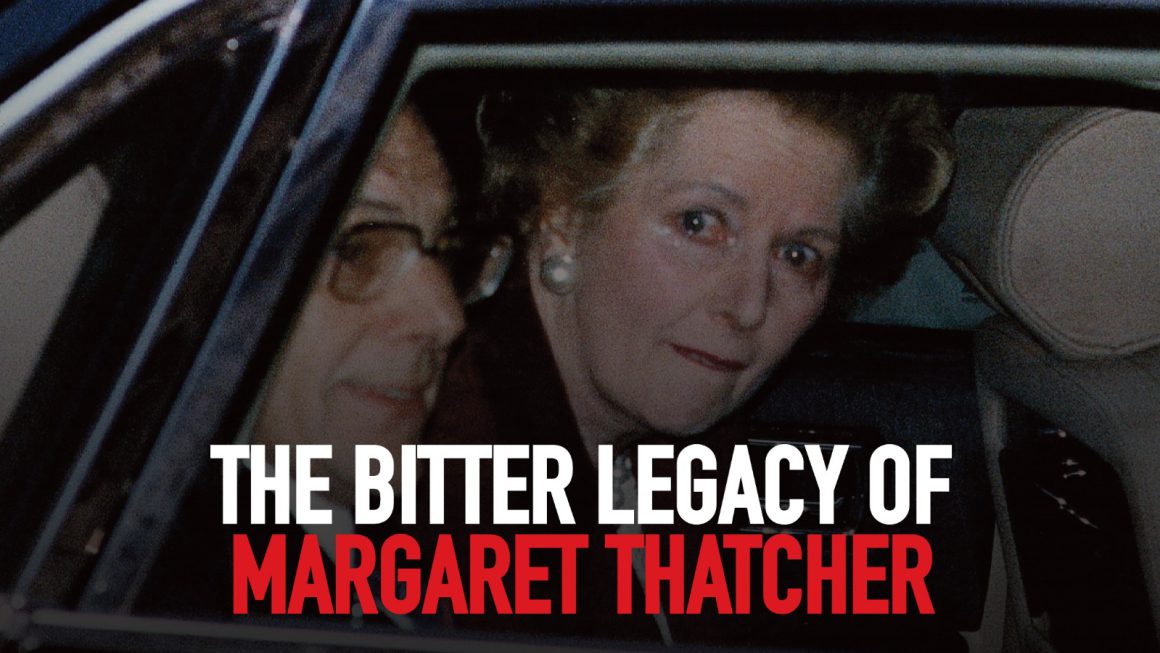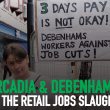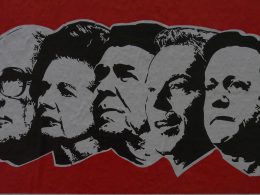By Mike Forster (Socialist Alternative- our sister organisation in England, Wales and Scotland)
Thirty years ago, Margaret Thatcher with tears in her eyes ended her eleven year reign as Prime Minister of Britain. A pioneer of neoliberalism, she fought for the interests of her class — the rich, while the working class grew to so hate her, many celebrated when she died.
On 28 November 1990, 30 years ago, Margaret Thatcher tearfully tended her resignation as Tory Party leader and therefore by default, as prime minister of the UK, after 11 years in power. She was forced out by a Cabinet coup against her and realised she was not going to succeed in the event of a leadership challenge. Her departure ended a period of rule which had completely changed the face of British and indeed international politics. It was also marked by huge celebrations in working class communities which had suffered massively at the hands of her brutal policies, but it would be another 7 years before the Tories were finally prised out of office. Thatcher’s reputation and legacy has left a deep scar across the whole face of British society which is still very keenly felt today by successive generations.
Thatcher’s reputation and legacy has left a deep scar across the whole face of British society which is still very keenly felt today by successive generations.
Thatcher’s anti working class government was a by-product of the slow but steady decline of British capitalism dating from the beginning of the twentieth century, but accelerated by the post war recession of the 1970’s. Labour had been in power from 1972 -1979 but in that period had been the first developed capitalist economy to bow the knee to demands from the International Monetary Fund to cut public spending, introduce wage restraint and rein in the power of the unions.
The assault on jobs and the public sector resulted in the infamous ‘dirty jobs’ strikes of 1978 which saw prolonged and coordinated strike action taken by some of the lowest paid workers, including medical staff, gravediggers and foremen against the anti-union policies of the the Callaghan Labour government. This resulted in many workers losing faith in Labour and allowed the Tories to narrowly win the election of 1979, bringing Britain’s first female prime minister to power.
Thatcher — pioneer of neoliberalism
There are many myths around Thatcher’s premiership, one of which was that she commanded big public support. Within a year, she was already the most unpopular prime minister in history. She was presiding over growing unemployment, which rose from 1,5 million to 3,5 million by 1984. She claimed to tame inflation, but although it was over 20% when she came to power, for most of her reign it varied from 5–10%.
The Trade Union movement held mass protests against her attracting hundreds of thousands and the Labour Party actually called demonstrations in Liverpool, Glasgow, Cardiff and London which brought out around 1 million onto the streets. A mood of resistance and defiance hung in the air. Rioting broke out in Bristol, London and Liverpool around excessive racist policing and the development of unemployment hotspots in blighted inner cities.
Thatcher ’s inner circle, which then reflected the interests of Britain’s ruling elite, had changed course economically, ditching consensus politics for harsh monetarist doctrines, the fore-runner of today’s neoliberalism. They advocated shrinking the public sector and dismantling heavy industry in favour of financial marketisation
This approach contradicted the entire history of British capitalism which had become a major world power through manufacturing and industrial development. When Thatcher came to power, manufacturing accounted for 40% of UK GDP which fell away dramatically for the rest of the decade and up to this day, accounting for less than 10% of GDP.
When Thatcher came to power, manufacturing accounted for 40% of UK GDP which fell away dramatically for the rest of the decade and up to this day, accounting for less than 10% of GDP.
Public spending fell from 44% of GDP to just 39% when she left office. Instead the Tories offered tax cuts and a forced reliance on the financial markets. They lifted exchange controls on British currency and foreign capital began to pour into the City of London. Thatcher completed this revolution when the London Stock Exchange was deregulated in 1986 and became one of the largest financial centres of speculation and profiteering in the world.
Although the ‘Big Bang’ in the City created a huge illusion of wealth creation, in reality it was opening the way for the financial crash of 2007–9. Markets became massively over inflated with debt and speculation. Marxists warned at the time, she was sowing the seeds of a major catastrophe. Although this took time to feed itself through, the crash of 2007–09 and today’s deep recession has its firm roots in Thatcher’s monetarist experiment.
This ‘Get Rich’ mentality was positively encouraged by Thatcher, even though it was clearly at the expense of the poorest sections of society. A new brutal and heartless ideology was pursued by Thatcher which led to her declaring. ‘there was no such thing as society’. These ideas have proven to be empty and hollow nonsense when humanity has faced up the Covid pandemic which has required working class society coming back together in heart-warming displays of solidarity and mutual cooperation.
These policies ravaged working class communities. Thatcher was on course for election disaster even as late as 1982. History dealt her an opportunity to play the nationalist card when Argentina invaded the Falklands Islands in the same year.
Thatcher took a serious gamble and chose to dispatch a war armada to allegedly ‘liberate’ the Falklands people from the military dictator, President Galtieri. This was a conflict she almost lost, but Galtieri’s young conscript army proved to be no match for superior air power, but not before Thatcher had ordered the infamous sinking of the Argentine warship, Belgrano, as it was actually sailing away from the conflict, resulting in the loss of over 700 lives.
In reality, Thatcher’s future was intrinsically tied to a military victory and she saw the brutal downing of the Belgrano as necessary collateral damage. The surrender of Argentine troops earnt Thatcher the title of the Iron Lady. In the following year’s election, wrapping herself in the union jack, she swept Labour and its hapless leader, Michael Foot, aside and was returned to power for another term.
Labour’s response
In the early 1980’s, the Labour Party had undergone something of a transformation. The left wing was in the ascendancy and membership grew rapidly. Left union leaders and constituency activists forced through changes to bring in automatic reselection of MP’s, so that members could control who their candidates would be, and a Party veto over the manifesto, putting control over Party decision making into the hands of its conference. The figure head of the left, Tony Benn, called for a mass socialist Labour Party and stood for deputy leader. He narrowly missed winning this position at the 1981 party conference but shortly afterwards, four right wing MP’s deserted Labour to set up a new Party (the Social Democratic Party led by the gang of four as they became known). This calculated manoeuvre, designed to undermine the left, also split the Labour vote in 1983 and gave Thatcher a 144-seat majority!
We have of course seen similar betrayals by the modern-day right wingers who deliberately set out to undermine Corbyn in the election of 2017, betraying their preference for a Tory government over a left led labour Government. These right wingers should go down in the Labour Movement’s Hall of Shame as they paved the way for Thatcher’s onslaught on jobs, housing, the unions and democratic rights.
Thatcher confronts the trade unions
Thatcher set her sights on taking on the might of the British Trade Union Movement. The Tories had never forgotten their humiliation at the hands of the miners in 1972 and 1974, when two successive strikes had forced the Tories to retreat. In 1974, the then Tory leader, Edward Heath, called a general election in the midst of the strike, asking the question, ‘who runs the country, the government or the miners?’. The result was a Labour victory and the Tories were ingloriously kicked out of power.
The Miners’ strike 1984–5
Thatcher’s infamous Tory Cabinet member, Nicholas Ridley, had gone away to plan how the miners might be defeated in another strike. His secret plan was endorsed by Thatcher, including the recruitment of a national strike breaking police force, stockpiling of coal, recruiting strike breaking lorry drivers, withdrawing any benefits for strikers, and giving the government more anti-union powers. The Tories provoked a strike in 1984 by threatening the closure of several pits and the year long strike took hold. This was one of the most bitter periods of class struggle in Britain’s post war history. The ruling class was out to destroy Britain’s most powerful union, the National Union of Mineworkers, rightly described by Militant, the forerunner of Socialist Alternative, at the time as a ‘civil war without bullets’.
The outcome of the strike was a tragic defeat for the miners, but a victory for the NUM would have changed the course of history in favour of our class. It is therefore all the more tragic that both Labour and Trade Union leaders stood by and allowed the British State to inflict this terrible blow. The then Labour leader, Neil Kinnock, condemned picket line ‘violence’, refusing to support their struggle. Calls for general strike action by the TUC were likewise dismissed by its leader, Norman Willis, and the miners were left to fight alone. Despite this, the miners were close to victory; Thatcher later revealed that she had been seeking a way out when the strike was called off. A dignified but defeated union membership marched back to work without a settlement. Thatcher wasted no time in destroying the industry: a workforce of 230,000 has been reduced to less than 4,000 today.
What followed was a rout of other major industrial workplaces and unions: dock, car, steel, print, and engineering workers witnessed large scale closures or privatisation, sometimes after brief and bitter strike action. Unemployment soared from 5.3% to 11.4 % by the mid 1980’s. The number of workers on sickness benefit doubled to 1.6 million, artificially disguising an unemployment figure nearer to 20% of the workforce. Three million manufacturing jobs were destroyed mainly in the Northern heartlands. Union membership slumped from its highpoint of 13.2 million members to an all-time low by the end of the decade of around seven million and fell even further through the 1990’s. Poverty levels soared; whilst the richest 10% saw their incomes rise by 35%, for the poorest sections, incomes fell and the number of children living in poverty increased from 1.7 million to 3.3 million by the time she left office.
There[cg1] is little wonder that thousands of workers partied all day long when Thatcher died in 2013. She left a bitter legacy of broken homes, communities and families; a scar which has never healed.
Thatcher’s war on local authorities
Thatcher also chose to go to war against Labour Councils, slashing the amount Councils received from central government and imposing legal caps on their ability to raise funds locally. This left Councils with a choice of either choosing to challenge her attacks or carrying out her dirty work and imposing cuts to services or raising rates (local taxes), or even both. Initially an impressive united front of up to 20 Labour Councils combined together to refuse to impose the Tory cuts. There were even mass Town Hall protests called by local Council leaders such as David Blunkett in Sheffield who was then seen as a leading left firebrand. However, one by one, they capitulated to combined legal threats and demands from Labour’s national leadership to ‘toe the line’, choosing in the end to set ‘legal’ budgets which of course meant cuts and rate increases.
Socialist led Liverpool City Council stood out in this process by refusing to bow the knee. In sharp contrast to the other councils, they committed to defy the Tories and to set an illegal or ‘needs’ budget. Their defiance and clear fighting approach inspired the huge support of the working class of Liverpool who heeded the calls to protests and strikes when called upon to support their council. More impressively, the Labour vote continued to go up every year from the beginning of their struggle in 1981 when Militant supporters in the Labour Party assumed the leadership of the Council. In a huge standoff in 1984, during the miner’s strike, Thatcher’s government backed down and gave the Council financial support to carry out their house building and jobs creation programme without a huge rate rise. The Militant inspired Council had proved that Thatcher could be beaten when confronted by determined and militant resistance.
Regrettably, this lesson was lost on the new Labour leadership of Neil Kinnock and Roy Hattersley who launched a prolonged and disgraceful witch-hunt against the Liverpool Council leaders at the 1985 Labour party Conference. This represented a significant watershed in Labour’s history. The attack on Labour’s Marxist wing did not stop there. Bit by bit the gains of the left in Labour from the early 80’s were whittled away for the next decade until Tony Blair was able to declare he was now leading ‘New Labour’ in 1998. Effective opposition to Thatcher’s counter revolution was therefore tamed and she was able to push ahead with further attacks on the working class. After she left office, Thatcher was asked what her greatest achievement had been and without hesitation, she replied, “New Labour”. No surprise then that she was the first to be invited into Downing Street by Tony Blair when he won the 1997 election.
Privatisation of the public sector
Thatcher was also responsible for extensive privatisation. Key industries which had been in public hands were sold off to the private sector including British Gas and Electricity, British Telecoms, Leyland, Oil, Airways, Steel, Petroleum, and Jaguar followed by the water companies. Other utilities and travel networks followed suit under the John Major government. This obscene sell off represented a massive transfer of wealth from the public sector to the asset strippers and the rich. It was accompanied by the hideous sale of public housing assets to create what she called a ‘property owning democracy’. Throughout the 1980’s, she introduced legislation which allowed council house tenants to buy their own homes, taking just short of one million homes out the public sector and seeing home ownership rise from 10.2 million in 1981 to 13.4 million by the end of the decade.
This brought her temporary support from some former Labour voters who bought into the illusion of wealth creation but the rapid rise in house prices and interest rates throughout the decade priced most of them out the market. The legacy of this appalling legislation is now written large in the huge rise of homelessness and record shortage of social housing.
Thatcher was able to secure a third term in 1987 on the back of a temporary economic upswing fuelled by credit and debt, but which nevertheless created the illusion of rising living standards. In reality, a large section of the working class had been left behind but Neil Kinnock’s appalling leadership of the Labour Party gave the Tories the political space to win again.
The rusting of the ‘Iron lady’
Thatcher became overconfident in her final term. She made the mistake of judging the mood of the masses by their insipid leadership. She chose to introduce the poll tax-an unfair and unequal tax to be imposed on every householder, regardless of income, as a way of replacing the local rates system which levied household income based on house value.
It was a direct attack on workers living standards which they could not afford. The demoralised leadership of the Labour and Trade Union Movement railed against the inequality of the tax, but offered no coherent fighting alternative. Only the Militant, staying true to its class, advocated a mass non-payment campaign. We knew there was a brewing discontent which could easily spill over and crystallise around this tax.
Thatcher’s second mistake was to use Scotland as a guinea pig where the poll tax was introduced a year early. Through community door to door canvassing, anti-poll tax campaigners built up huge anti poll tax unions in every estate. ‘No Poll Tax Here’ window posters festooned inner city tenements. When the poll tax became law in Scotland, one million people had refused to pay making it completely uncollectable. Undimmed, Thatcher pressed on creating an incredible 14 million non-payment army in England and Wales, culminating in huge simultaneous demonstrations in Glasgow, and London on 31 March 1990. Non-payment actually rose throughout the year and sent council finances into turmoil. The tax had dismally failed, and the Tory grandees finally plucked up the courage to have Thatcher removed at the end of the year.
The original Brexiteer
Her other legacy was to encourage hostility and suspicion towards the European Union. Initially she was a strong advocate of the EU and supported strengthening trading ties. However, when that spilled over into closer political union, she began her crusade against further integration. It was this stand which appealed to the rampant right-wing nationalists in her Party and shifted the Party onto a far more hostile attitude to the EU. This approach haunted her successor’s time in office (John Major) who described the nationalist opposition the EU as ‘bastards’. This also allowed Boris Johnson to claim he stands in the tradition of Thatcher which ironically continues to tear the Tory Party apart and helped lead to Brexit.
Lessons
Thatcher was a creation of her time, feared and loathed in equal measure. We study this period because it remains rich in lessons, most notably for the defeats which were inflicted on her by organised socialist forces on the ground. When all too often, we are told that right wing dictators or leaders are all powerful, we should remind ourselves how the Iron Lady was forced back. When inspired and confidently led, working people will always struggle and can win, as we have proved today in Seattle. Regrettably, she was allowed to inflict huge misery and hardship on millions of working people and set a different course for British society which we must never forget. Although still praised and lauded by Tory stalwarts today, her policies also paved the way for huge splits we see today in the Tory Party around Europe and of course the financial ruin in the economy. Thatcher’s period in power paved the way for the massive demise of British Capitalism and with it, the Tory Party.












